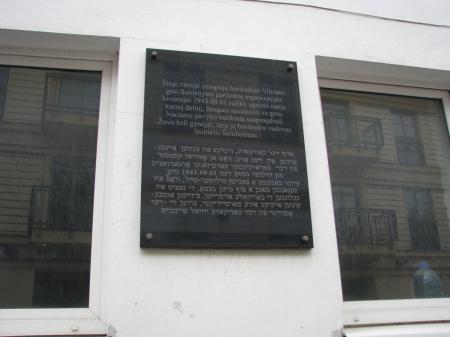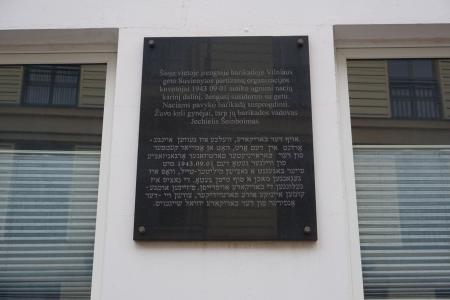Obj. ID: 45499
Modern Jewish Art Memorial Plaque to Yehiel Sheynboym in Vilnius, Lithuania, 2000
To the main object: Žemaitijos (Strašūno) Street in Vilnius, Lithuania

Memorial name
No official name.
Who is Commemorated?
Fighters of the United Partisan Organization (FPO) who defended Strašūno (now Žemaitijos) Street on September 1, 1943, and their leader Yehiel Sheynboym, who was killed during the fight.
Description:
A black marble plaque is fixed to the wall of a new building at 8a Žemaitijos St., constructed after WWII on the site of the building whose address during the war was 12 Strašūno St.
The plaque contains two identical inscriptions in Lithuanian and Yiddish.
Inscriptions:
In Lithuanian:
Šioje vietoje įrengtoje barikadoje Vilniaus
geto Suvienytos partizanų organizacijos
kovotojai 1943 09 01 sutiko ugnimi nacių
karinį dalinį, žengusį susidoroti su getu.
Naciams pavyko barikadą susprogdinti.
Žuvo keli gynėjai, tarp jų barikados vadovas
Jechielis Šeinboimas.
In Yiddish:
אויף דער באריקאדע, וועלכע איז געווען איינגע-
אָרדנט אין דעם אָרט, האָט אן אָטריאד קעמפער
פון דער פאראייניקטער פארטיזאנער אָרגאניזאציע
פון ווילנער געטאָ דעם 1943.09.01 מיט
פייער באגעגענט א נאצישן מיליטער-טייל, וואָס איז
געגאנגען מאכן א סוף מיטן געטאָ. די נאציס איז
געלונגען די באריקאדע אויפרייסן. ס'זיינען אומגע-
קומען אייניקע אירע פארטיידיקער, צוושן זיי – דער
אָנפירער פון דער באריקאדע יחיאל שיינבוים.
Translation: On the barricade that was organized in this place, a fighting unit of the United Partisan Organization of the Vilnius Ghetto, on September 1, 1943, met with fire a Nazi military unit that went to make an end of the ghetto. The Nazis succeeded to destroy the barricade. Some of its defenders perished, among them the leader of the barricade, Yehiel Sheynboym.
Commissioned by
the Lithuanian Jewish Community. Funded by the German embassy to Lithuania.
sub-set tree:
On September 1, 1943, the United Partisan Organization (FPO) in the ghetto expected that German units were planning to enter the ghetto in order to annihilate it. Therefore, they occupied several positions in houses along the Strašūno Street. The Germans indeed entered the ghetto and called its inmates to come out from their hiding places. The Germans stopped at 15 Strašūno Street and blew it up. After that, Yehiel Sheyboym’s fighting unit opened fire on the Germans from 12 Strašūno Street. Sheynboym was killed by returning fire. After that, the Germans blew up the building and only a few defenders escaped. Rubble from the buildings blocked Strašūno Street, stopping the German advance. Fearing to remain in the ghetto after dark, the Germans retreated (Guzenberg 2021, 182).
The plaque at the site of the former 12 Strašūno Street was unveiled on September 28, 2000, the anniversary of the annihilation of the ghetto, and Holocaust Memorial Day in Lithuania.
Agranovskii, Genrikh and Irina Guzenberg. Vilnius: Po sledam Litovskogo Ierusalima. Pamiatnye mesta ereiskoi istorii i kul’tury, 2nd ed. (Vilnius: The Vilna Gaon Jewish State Museum, 2016)., 174.
Guzenberg, Irina, Vilnius: Traces of the Jewish Jerusalem of Lithuania. Memorable Sites of Jewish History and Culture. A Guidebook (Vilnius: Pavilniai, 2021)., 181.
Guzenberg, Irina. Vilnius: Pamiatnye mesta evreiskoi istorii i kul'tury (Vilnius: Pavilniai, 2013)., 52.







